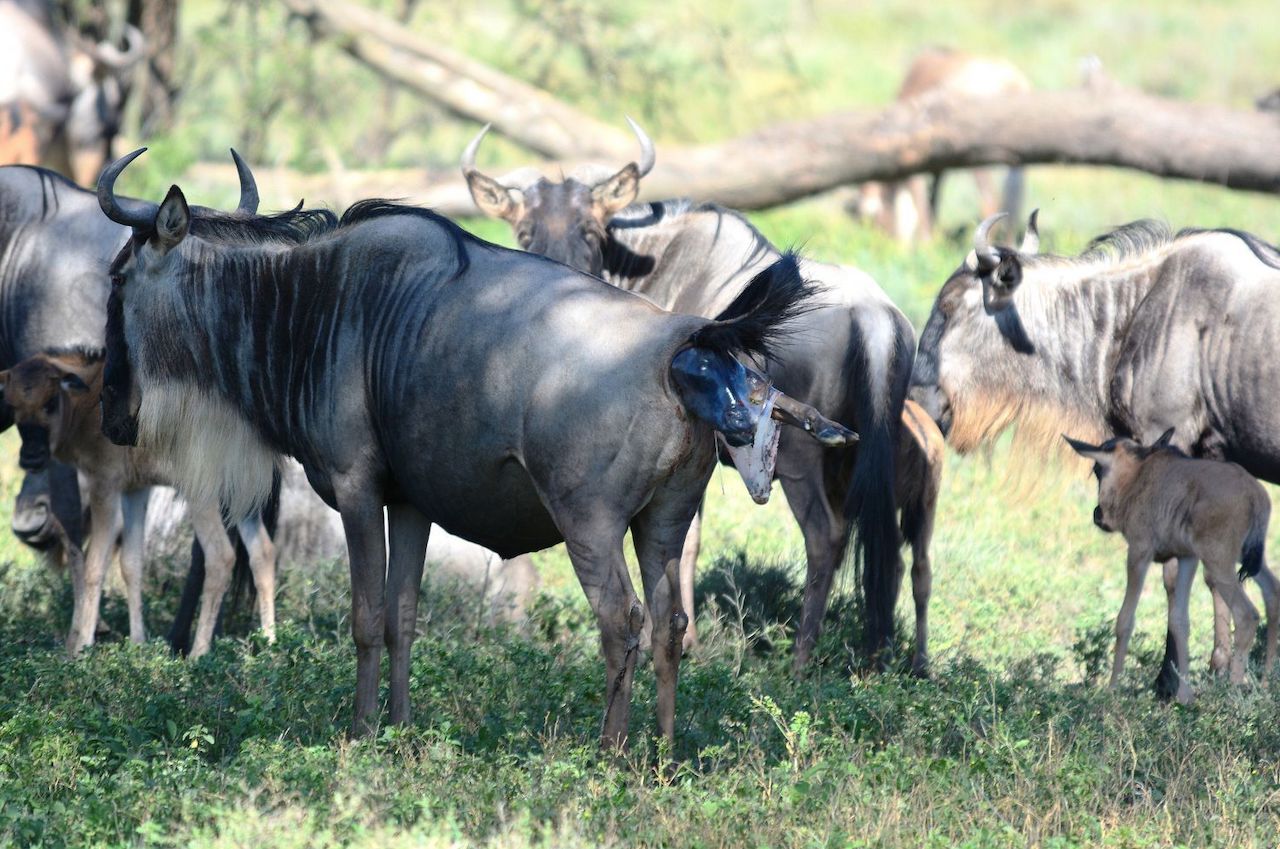The Serengeti ecosystem is home to one of the world’s most breathtaking natural spectacles: the Great Migration. Each year, over one and a half million wildebeests and two hundred thousand zebras, embark on a circular journey across the vast plains of the Serengeti and Maasai Mara in search of new grass and water. This article will explore the fascinating details of this incredible event, from the animals involved to the obstacles they face along the way.
The great wildebeest migration is one of the most spectacular natural events in the world. This incredible journey, driven by instinct and the need for survival, is a reminder of the beauty and resilience of nature. The migration has a significant impact on the ecosystem of East Africa, helping to maintain the grasslands and support the region’s biodiversity. It is also a key driver of the local economy, attracting tourists from all over the world. If you ever have the opportunity to witness the wildebeest migration, don’t pass it up – it is an experience that you will never forget.
The Great Migration: A Journey Across the Serengeti Ecosystem

The Great Migration is a massive journey that covers an area of around 40,000 sq. km. and involves four key regions: the Serengeti National Park, the Maasai Mara Reserve, the Ngorongoro Conservation Area, and neighboring plains. Most of the migration area is located in Tanzania, except for the Maasai Mara Reserve, which is in Kenya.
The migration is driven by the need for water and new pastures, which is why the wildebeests and zebras embark on this circular journey every year. The southern Serengeti and Ngorongoro Conservation Area plains are especially fertile, making them an attractive destination for these animals. However, they face many obstacles along the way, including crossing rivers infested with crocodiles and avoiding predators such as lions, leopards, hyenas, wild dogs, vultures, jackals, and cheetahs.
If you are an avid wildlife enthusiast, then you have probably heard of the great wildebeest migration, one of Africa’s most awe-inspiring natural events. This annual migration is a phenomenon that takes place between the Maasai Mara National Reserve in Kenya and the Serengeti National Park in Tanzania. In this article, we will delve deeper into this remarkable event, exploring its history, what causes it, and the impact it has on the ecosystem.
The Great Wildebeest Migration: Africa’s Greatest Wildlife Spectacle
The wildebeest migration is an incredible natural event that has fascinated people for centuries. It is a testament to the beauty and resilience of nature and the power of instinct. This annual event is often referred to as the “greatest wildlife spectacle on earth,” and for good reason. Millions of wildebeest, accompanied by thousands of zebras, gazelles, and other herbivores, traverse the grasslands of East Africa, in search of fresh pastures and water. This migration is a stunning display of the cycle of life and the interconnectedness of ecosystems.
What is the Wildebeest Migration?
The wildebeest migration is an annual event that sees millions of wildebeest, along with zebras and other herbivores, move from the Serengeti National Park in Tanzania to the Maasai Mara National Reserve in Kenya, and back again. This migration is driven by the need for the animals to find fresh grass and water, as the dry season takes hold.
During the migration, the wildebeest travel in herds, which can number in the tens of thousands. They face numerous challenges along the way, including crossing treacherous rivers, avoiding predators such as lions and crocodiles, and dealing with extreme weather conditions. Despite these challenges, the wildebeest migration is a truly remarkable event and one that draws thousands of visitors to East Africa each year.
Why does the Wildebeest Migration Occur?
The wildebeest migration is primarily driven by the changing seasons and the need for the animals to find fresh grazing land and water. In the dry season, which typically lasts from June to October, the wildebeest are forced to move north in search of water and green pastures. As the rainy season arrives, typically between November and May, the wildebeest migrate south to the Serengeti National Park, where they can graze on fresh grasses.
Our Safari Desire guides are always on the ground, which enables us to be up to date all the time about the location of the wildebeest’s herds as well as predict their next location. Our safari experts in the back office offer free advice and customization to anyone who wishes to visit Tanzania with the main aim of tracking and witnessing the wildebeest migration.
The Route of the Wildebeest Migration
 The wildebeest migration follows a circular route, which begins in the southern Serengeti and moves north towards the Maasai Mara. The migration typically takes place in two stages, with the first stage taking place between January and March, and the second stage occurring between July and October.
The wildebeest migration follows a circular route, which begins in the southern Serengeti and moves north towards the Maasai Mara. The migration typically takes place in two stages, with the first stage taking place between January and March, and the second stage occurring between July and October.
During the first stage of the migration, the wildebeest moves from the southern Serengeti to the western corridor, where they cross the Grumeti River. This is a treacherous crossing, with many wildebeest losing their lives to crocodiles and other predators. The second stage of the migration sees the wildebeest move from the Maasai Mara back to the southern Serengeti, crossing the Mara River along the way.
Impact of the Wildebeest Migration on the Ecosystem
The wildebeest migration has a significant impact on the ecosystem of East Africa and is a key driver of the region’s biodiversity. The migration helps to disperse nutrients across the landscape, providing a vital source of food for predators such as lions, hyenas, and vultures.
Additionally, migration plays a crucial role in the maintenance of the grasslands themselves. The wildebeest and other herbivores graze on the grasses, which helps to keep them short and promotes new growth. This, in turn, creates a healthier ecosystem for all the animals that live there.
The wildebeest migration also has a significant impact on the local economy.
Many tourists flock to East Africa each year to witness this natural wonder, providing a boost to the region’s tourism industry. This, in turn, helps to create jobs and support local communities.
The Great Migration and the Seasons
The position of the Great Migration varies with the alternation of seasons, combined with the events in the life of the herds. It is not easy to time the entire migration because the start of the rainy season varies, and so does the amount of rainfall. However, by tracking the migration month by month, we can get an idea of its position in the Serengeti ecosystem.

In January, the herds are in the southern Serengeti and Ngorongoro Conservation Area, where the grass is green and plentiful. February marks the start of calving season, and the wildebeests and zebras give birth to their young in large numbers. By March, the herds start moving towards the western corridor of the Serengeti, where the grass is still green and there is plenty of water.
In April and May, the herds continue moving northwards, crossing the Grumeti River and facing the dangers of the crocodiles that live there. In June, the herds reach the Maasai Mara Reserve, where the grass is once again green and plentiful. July and August are the best months to witness the Great Migration in the Maasai Mara Reserve.
In September and October, the herds start moving southwards again, crossing the Mara River and facing the dangers of crocodiles once more. November marks the start of the short rains, and the herds move towards the eastern Serengeti plains. Finally, in December, the herds return to the southern Serengeti and Ngorongoro Conservation Area, where the grass is once again green and plentiful.
The longer Wildebeests migration safaris in Tanzania usually include other interesting parks like Tarangire National Park, Lake Manyara National Park, and Ngorongoro Crater, together which makes up the Northern Tanzania safari circuit.
Following the Great Migration
Many tented camps are mobile and change location to follow the annual wildebeests and zebras trails. This makes it possible to witness the Great Migration up close and personal. It’s an unforgettable experience to watch the massive herds thundering across the plains, kicking up dust as they move.
How to understand the position of the Great Migration in the Serengeti Ecosystem • The Great Migration month by month • The Great Migration with the alternation of the seasons • The Great Migration based on the lifecycle of the wildebeests and zebras
The Importance of Conservation Efforts
The wildebeest migration is not just a natural wonder, but it is also an important ecological event. It is crucial to maintain the balance of the ecosystem, and migration plays a significant role in this. However, the wildebeest are under threat due to habitat loss, poaching, and climate change. It is essential to support conservation efforts to protect these majestic creatures and their habitat.
FAQs about the Wildebeest Migration

The Great Migration is a magnificent display of nature’s beauty and the eternal struggle for survival. It’s an awe-inspiring event that draws visitors from all over the world, and rightly so. By understanding the position of the Great Migration in the Serengeti ecosystem, we can appreciate the scale and complexity of this incredible journey.
How many wildebeest are there in the migration?
It is estimated that there are around 1.5 million wildebeest in the migration each year.
What other animals can be seen during the migration?
In addition to wildebeest, the migration also includes zebras, gazelles, and other herbivores. Predators such as lions, hyenas, and cheetahs can also be seen.
What is the best time of year to see the migration?
The migration takes place year-round, but the best time to see it is between July and October when the wildebeests are in the Masai Mara, Kenya.
How long does the migration last?
The migration is a year-round event, but the wildebeest typically spends around 4 months in the Maasai Mara.
How far do the wildebeest travel during the migration?
The wildebeest herds travel a distance of around 800 kilometers during the migration.
What are some of the dangers that the wildebeest face during the migration?
The wildebeest face numerous dangers during the migration, including crossing treacherous rivers, avoiding predators such as lions and crocodiles, and dealing with extreme weather conditions.

